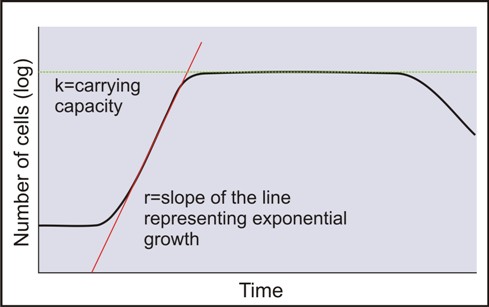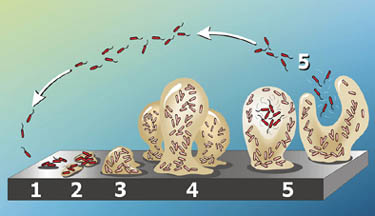K and r Reproductive Strategies
In the equations describing growth of populations of organisms, r represents the slope of the line representing exponential growth. The letter K represents the carrying capacity of a habitat for members of a given sort of organism. The terms r-selection and K-selection have also been used by ecologists to describe the growth and reproductive strategies of various organisms.

Figure 3. Bacterial Growth Curve representing r and K Reproductive Strategies.
Those organisms described as r-strategists typically live in unstable, unpredictable environments. Here the ability to reproduce rapidly (exponentially) is important. Such organisms have high fecundity (glossary) and relatively little investment in any one progeny individual, they are typically weak and subject to predation and the vicissitudes of their environment. The “strategic intent” is to flood the habitat with progeny so that, regardless of predation or mortality, at least some of the progeny will survive to reproduce. Organisms that are r-selected have short life spans, are generally small, quick to mature and waste a lot of energy. Typical examples of r-strategists are
- salmon
- corals
- insects
- bacteria
K-strategists, on the other hand occupy more stable environments. They are larger in size and have longer life expectancies. They are stronger or are better protected and generally are more energy efficient. They produce, during their life spans, fewer progeny, but place a greater investment in each. Their reproductive strategy is to grow slowly, live close to the carrying capacity of their habitat and produce a few progeny each with a high probability of survival. Typical K-selected organisms are elephants, and humans. The table below summarizes some of the differences between r-organisms and K-organisms.
Characteristics of r- and K-selected organisms |
|
r-organisms |
K-organisms |
short-lived |
long-lived |
small |
large |
weak |
strong or well-protected |
waste a lot of enrgey |
energy efficient |
less intelligent |
more intelligent |
have large litters |
have small litters |
reproduce at an early age |
reproduce at a late age |
fast maturation |
slow maturation |
little care for offspring |
much care for offspring |
strong sex drive |
weak sex drive |
small size at birth |
large size at birth |
Note: Not all characteristics apply to all organisms. It is not suggested, for example, that some bacteria have a stronger sex drive or are more intelligent than others. From Principa Cybernetica, http://pespmc1.vub.ac.be/DEFAULT.html
|
|
It is not surprising that many organisms cannot be categorized neatly into this r vs. K scheme. Many organisms adopt an intermediate strategy or even adopt different strategies depending on local conditions at any given time. In fact, an organism capable of alternating between an r-strategy and a K-strategy might well be the best-fit organism over all because its adaptability permits survival under a broader range of conditions.
It can be argued that biofilms have accomplished this balancing act through the adoption of mechanisms that permit the alternation between the biofilm and the planktonic cell life styles. Biofilms are large (relative to planktonic cells) and grow slowly over days or weeks, rather than minutes. Their metabolic rate resembles stationary cells more than exponential phase ones. Biofilms are, not only tough; they can alter their local environment by the production of an EPS matrix, which increases their resistance to predation and chemical attack. Their typical mode of reproduction is by fragmentation or sloughing in which, large fragments separate from the biofilm mass and may form secondary colonies downstream with a relatively large chance of survival (once again in comparison with planktonic cells). Biofilms, particularly multiple species biofilms, are energy efficient in that the metabolic product of one organism which, could easily accumulate to inhibitory levels, may become the substrate for another. Thus the first organism benefits by having a metabolic waste product removed and the second benefits in having a critical nutrient supplied. Thus at nearly every point, bacterial cells incorporated into biofilms appear to behave as K-strategists (see figure 4).
Figure 4. Formation of New Biofilm Colonies Through Detatchment.
Davies and his colleagues have shown that when Pseudomonas aeruginosa biofilms experience an influx of carbon containing nutrients (eg. succinate, glutimate or glucose), they respond by inducing certain cells with in the biofilm matrix to enter a dispersive mode. These cells down-regulate pilus genes and up-regulate genes for flagella proteins adopting what the investigators term a dispersal phenotype. Eventually the cells enclosing the biofilm lyse releasing the newly formed motile planktonic cells. These cells are, of course, r-selected in that they reproduce exponentially at the maximal rate permitted by the environment. The chance of any one cell finding an appropriate surface on which to attach and form another biofilm is small, but their numbers are huge. Davies et al. write that this dispersal mode is not an all or none phenomenon, but rather can occur at a low level at any point during biofilm formation.
In their now-famous article, Biofilm: City of Microbes, Watnick and Kolter have referred to the biofilms as “microbial cities” and the planktonic cells as "pioneers" or "explorers" whose primary function is the “translocation [of cells] from one surface to another”. Evidence from proteomic studies suggests that that “biofilm formation versus dispersal and cell motility often represent opposite sides of the regulatory coin” (Romeo, 2006).
